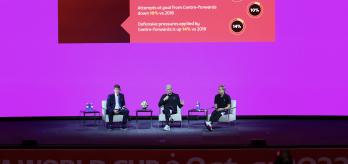The goalkeeper is a unique position on the pitch – so much so that, at times, the way we perceive and analyse goalkeeping has been entirely decoupled from outfield play. However, the tournament in Qatar is continuing to prove that this is not the case in modern football; the goalkeeper is deeply intertwined with the rest of their team, and a 'keeper's performance can only be fully understood by bringing outfield team-mates and the wider game into the picture. In episode three of FIFA Insight, Zuberbühler and Mondragón, in a discussion with FIFA's Group Leader Football Performance Analysis & Insights Chris Loxston, showcase how the goalkeeper's role in build-up play, their positioning in relation to the defensive line, and their variety of distribution are proving significant.
Watch video
Read summary
00:27
Goalkeeper line height
Goalkeepers adopt different positions depending on where the ball is on the pitch, but we see that when the ball is in the middle third, defences have pushed 7m further up the pitch than in 2018, and the average goalkeeping position has pushed up by 4m. This may not sound like much, but as our examples show, it can be the difference between stopping shots and conceding goals.
10:21
The rise of the 'sweeper-keeper'
In past decades, many teams played with a sweeper (also known as a libero) behind the defence. At this World Cup, we have seen that goalkeepers are increasingly playing this role, acting as 'sweeper-keepers.' As our clips show, sweeper-keepers can be very effective, but this is a highly specialised role that requires constant training with the entire squad. The goalkeeper needs to learn to read the game and stay one step ahead of the opposition, while their team-mates need to know instinctively where the goalkeeper will be in relation to their defence.
13:30
Goalkeeper involvement in build-up play
Over recent years, goalkeepers have generally become much more comfortable with the ball at their feet. The data for this area, which is guided by the FIFA Goalkeeping Expert Group's Distribution Framework, reflects this change. The figures indicate that goalkeepers are 'playing around' the opposition more often, as opposed to playing long balls directly 'onto' the strikers. This shows that modern goalkeepers are expected to play a significant role in starting attacks, and to do that, they need to be capable of playing the full range of passes.
15:53
Goalkeepers offering to receive the ball
Finally, we have also observed massive increases in the number of times goalkeepers have offered to receive the ball (up 64% since 2018), and in the number of times they have actually received it (up by 100%). This reflects the fact that goalkeepers are expected to act as a focal point for their team's build-up and to show the same level of technical ability on the ball as any other defender. Again, training goalkeepers to perform the role of an eleventh outfielder means integrating them fully into the rest of the squad, and into their team's overall system.













